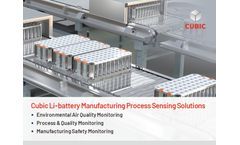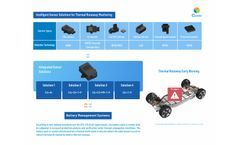Battery Life Cycle Management Solutions Articles & Analysis
29 articles found
Smart, safe, and practical storage steps (for Li-ion & LiFePO₄) that extend service life and reduce risk Storing lithium batteries the right way isn’t glamorous, but it’s where healthy performance and safety begin. Whether you’re protecting spare packs for power tools, e-bike batteries, or an array of LiFePO₄ modules from a brand like RICHYE, small changes to how you store ...
In contrast, LiFePO₄ batteries allow up to 80–100% DoD while still delivering thousands of cycles. ...
Optimize Efficiency, Safety, and Longevity with Today’s Smart Charging TechnologiesIn the rapidly evolving world of off-grid power systems, the solar charge controller is the unsung hero that governs how your photovoltaic (PV) array interacts with your lithium battery bank. Whether you’re powering a remote cabin, an RV, or a portable camping setup, choosing the right controller ensures maximum ...
Upgrading your golf cart battery pack from traditional lead‑acid to modern lithium iron phosphate (LiFePO₄) chemistry represents one of the smartest investments you can make—whether you’re cruising fairways, navigating sprawling campuses, or touring residential communities. Lithium batteries deliver more usable capacity, faster charging, lighter weight, and virtually zero maintenance. ...
Key advantages include: Higher Depth of Discharge (DoD): Up to 90% usable capacity versus 50% for lead‑acid, translating to greater usable energy per cycle. Longer Cycle Life: 4,000–6,000 cycles compared to 500–1,000 for traditional batteries, offering years of reliable service. ...
Lithium Nickel Manganese Cobalt (NMC): Higher energy density for space‑constrained installations, although slightly shorter cycle life than LiFePO₄. Meet RICHYE: Your Trusted Lithium‑Battery Partner RICHYE is a professional lithium‑battery manufacturer whose products excel in quality, performance, safety, and value. With ...
Industrial Sites: Remote mining or research stations utilize modular battery banks for silent, emission‑free operation. High‑efficiency inverters and intelligent energy management systems optimize charge life and prioritize critical loads, ensuring that finite stored energy delivers maximum benefit. ...
The right connection strategy can maximize energy transfer, simplify maintenance, and prolong battery life—while the wrong choice risks voltage drop, overheating, and even catastrophic failure. ...
We’ll also introduce RICHYE, a lithium battery specialist whose advanced solutions power forward-thinking material handling fleets. 1. ...
The manufacturing of lithium-ion batteries requires a highly controlled environment, stringent safety protocols, and robust quality assurance mechanisms throughout every stage of production. The process is typically divided into five core steps:Step 1: Material PreparationStep 2: Electrode ManufacturingStep 3: Cell AssemblyStep 4: Formation & AgingStep 5: Final Testing At each of these ...
In the production and application of lithium batteries, thermal runaway is a critical safety concern. Thermal runaway is a phenomenon in which the internal temperature of a lithium battery rises sharply due to overcharging, over-discharging, short circuits, or external high temperatures, triggering a chain reaction, leading to fires or even explosions, potentially causing severe accidents. During ...
Depth-of-Discharge (DoD): Percentage of battery capacity used before recharging. State-of-Charge (SoC): Remaining capacity, typically monitored by a battery management system. ...
A Professional Guide to Sizing, Wiring, and Maintaining Your Off-Grid Energy Storage System In an era where sustainable energy solutions are both accessible and necessary, building a DIY solar battery bank has never been more appealing. ...
Deep-cycing below 10% regularly can shorten lifespan. Many modern BMS (Battery Management Systems) include low-voltage cutoffs to safeguard the cells. ...
Modern hybrid inverters intelligently switch between grid, PV, and battery sources. Battery Bank: Usually lithium-ion technology (LiFePO₄) is preferred for its high cycle life and depth-of-discharge (DoD). ...
High-purity copper (usually refers to a purity of 5N to 7N, i.e. 99.999% to 99.9999%) is a metal material with excellent physical and chemical properties. Properties of high-purity copper Electrical conductivity and thermal conductivity: High-purity copper has extremely high electrical conductivity and thermal conductivity, which makes it very useful in electronic and thermal management ...
Summary In September 2018, Open Energi began helping Sapphire Battery Energy Ltd to maximise the energy trading revenues from their 0.5MW Tesla battery co-located with rooftop solar PV, one of Britain’s first and largest “behind the meter” commercial and industrial solutions. The complex solar site is optimised against a range of export and import opportunities, including Firm ...
Nowadays, the widespread adoption of electric vehicles (EVs) has brought about an increased focus on automotive safety, particularly concerning thermal runaway, a potential risk leading to fires or even explosions. Thermal runaway events not only pose a significant threat to passenger safety but also result in substantial property damage. In recent years, several severe accidents have been ...
Thermal runaway in lithium-ion batteries is a critical concern for safety in electric vehicles. To mitigate the risk of thermal runaway in lithium-ion batteries, it is crucial to proactively implement comprehensive monitoring solution to provide early warning as preventive step against potential harm from lithium-ion battery thermal runaway incidents. As mandated by UN GTR 20 and GB 38031:2020, ...
Let’s take a look at industrial battery engineering and see what is it and why is it important. Our detailed guide will help you understand the field. ...









